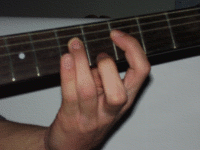Pull-off
File:Guitare hammer pulloff slide.ogg
Pull-off is a technique widely used in stringed instruments, particularly in the playing of guitars, bass guitars, and banjos. It involves plucking a string by "pulling" the finger off the string after it has been fretted, allowing a second note to sound. This technique is often used in conjunction with the hammer-on to perform fast sequences of notes without the need for picking each note individually. The pull-off allows for smoother, more legato phrases in music, which can be particularly useful in styles such as rock, blues, metal, and classical.
Technique[edit | edit source]
To execute a pull-off, a player first frets two notes on the same string; the note to be pulled off to, and the note to be pulled off from. The player picks the string and then pulls the finger off the fretted note, making sure to give a slight sideways flick to the string to sound the second note clearly. The efficiency of the technique relies on the pull-off being strong enough to make the second note ring out with sufficient volume, but also gentle enough to maintain a smooth sound.
Applications[edit | edit source]
Pull-offs are used in a variety of musical contexts. In lead guitar work, they are a fundamental part of playing fast and fluid solos. In rhythm guitar playing, they can add texture and complexity to chord progressions and riffs. Pull-offs also find their place in the intricate fingerstyle playing of classical and folk guitarists, where they contribute to the musicality and expressiveness of performances.
Benefits and Challenges[edit | edit source]
The main benefit of mastering the pull-off technique is the ability to play passages of music more fluidly and quickly than would be possible by picking every note. However, achieving a clear, consistent sound with pull-offs can be challenging, especially for beginners. It requires precise finger strength and control, as well as a good understanding of timing and rhythm.
Related Techniques[edit | edit source]
The pull-off is often used in combination with the hammer-on, where a note is sounded by fretting it with sufficient force to make it ring without picking. Together, these techniques are fundamental to the legato playing style, allowing for smooth and rapid sequences of notes. Another related technique is the slide, where a note's pitch is changed by moving a fretting finger up or down the string without re-picking the string.
See Also[edit | edit source]
Search WikiMD
Ad.Tired of being Overweight? Try W8MD's physician weight loss program.
Semaglutide (Ozempic / Wegovy and Tirzepatide (Mounjaro / Zepbound) available.
Advertise on WikiMD
|
WikiMD's Wellness Encyclopedia |
| Let Food Be Thy Medicine Medicine Thy Food - Hippocrates |
Translate this page: - East Asian
中文,
日本,
한국어,
South Asian
हिन्दी,
தமிழ்,
తెలుగు,
Urdu,
ಕನ್ನಡ,
Southeast Asian
Indonesian,
Vietnamese,
Thai,
မြန်မာဘာသာ,
বাংলা
European
español,
Deutsch,
français,
Greek,
português do Brasil,
polski,
română,
русский,
Nederlands,
norsk,
svenska,
suomi,
Italian
Middle Eastern & African
عربى,
Turkish,
Persian,
Hebrew,
Afrikaans,
isiZulu,
Kiswahili,
Other
Bulgarian,
Hungarian,
Czech,
Swedish,
മലയാളം,
मराठी,
ਪੰਜਾਬੀ,
ગુજરાતી,
Portuguese,
Ukrainian
Medical Disclaimer: WikiMD is not a substitute for professional medical advice. The information on WikiMD is provided as an information resource only, may be incorrect, outdated or misleading, and is not to be used or relied on for any diagnostic or treatment purposes. Please consult your health care provider before making any healthcare decisions or for guidance about a specific medical condition. WikiMD expressly disclaims responsibility, and shall have no liability, for any damages, loss, injury, or liability whatsoever suffered as a result of your reliance on the information contained in this site. By visiting this site you agree to the foregoing terms and conditions, which may from time to time be changed or supplemented by WikiMD. If you do not agree to the foregoing terms and conditions, you should not enter or use this site. See full disclaimer.
Credits:Most images are courtesy of Wikimedia commons, and templates, categories Wikipedia, licensed under CC BY SA or similar.
Contributors: Prab R. Tumpati, MD


